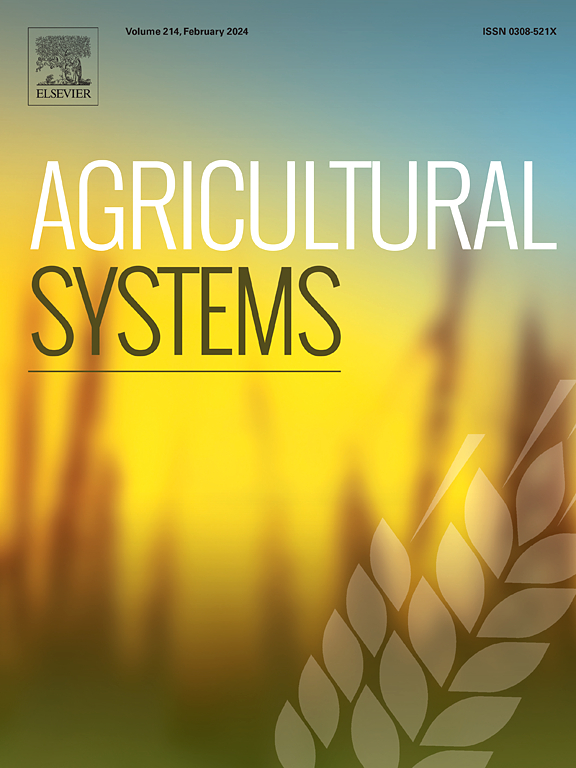饮食变化如何影响农业土壤的温室气体平衡?以丹麦为例
IF 6.1
1区 农林科学
Q1 AGRICULTURE, MULTIDISCIPLINARY
引用次数: 0
摘要
当前粮食系统约占人为温室气体(GHG)排放量的30%;因此,消费者的饮食偏好会对环境产生强烈的影响。众所周知,这是通过减少动物蛋白消费和相关的甲烷排放而实现的温室气体缓解。然而,饮食变化对土壤温室气体平衡的影响尚未得到全面评价。目的采用先进的基于过程的建模框架,以丹麦为例,全面评估EAT-Lancet健康饮食对国家一级土壤净温室气体平衡的影响。方法采用双侧研究方法。首先,我们使用经济一般均衡模型MAGNET来量化在欧盟(EU)采用EAT-Lancet健康饮食后,国家一级食品消费和土地利用的需求驱动变化。然后,我们使用基于DayCent过程的生物地球化学模型来评估这些变化对丹麦全国范围内农业土壤温室气体平衡的影响。结果和结论我们的研究结果表明,与一切照旧的饮食相比,全面采用EAT-Lancet参考饮食将导致2030年至2100年农业土壤中显著的碳损失(高达480 Gg CO2e y - 1)和N2O排放量增加(2.1%,代表50 Gg CO2e y - 1)。这些变化主要源于动物粪便对土壤的施用减少和永久草地的份额减少。不同土壤气候条件下土壤温室气体平衡差异较大。虽然这些结果并不能抵消通过减少畜牧业生产(1390 Gg CO2e y - 1)实现的温室气体减排,但它们强调了全面考虑土壤温室气体排放的重要性,因为它们抵消了采用植物性健康饮食的一些好处。最后,土壤净温室气体平衡的显著区域差异突出了在其他区域和更大尺度上进行空间明确评估的必要性。本文章由计算机程序翻译,如有差异,请以英文原文为准。

How do diet shifts affect the greenhouse gas balance of agricultural soils? Denmark as a case study
CONTEXT
Current food systems account for approximately 30 % of anthropogenic greenhouse gas (GHG) emissions; therefore, consumers' dietary preferences can have strong environmental consequences. This is well known for the GHG mitigation achieved by reducing animal protein consumption and associated methane emissions. However, the impact of diet shifts on the soil GHG balance has not been comprehensively evaluated yet.
OBJECTIVE
To comprehensively assess the impact of the EAT-Lancet healthy diet on the net soil GHG balance at a national level with an advanced process-based modelling framework, using Denmark as a case study.
METHODS
We adopted a two-sided approach. Firstly, we used the economic general equilibrium model MAGNET to quantify the demand-driven changes in food consumption and land use at the national level following the adoption of the EAT-Lancet healthy diet for the European Union (EU). We then used the DayCent process-based biogeochemical model to assess the implications of these changes for the GHG balance of agricultural soils at a national scale in Denmark.
RESULTS AND CONCLUSIONS
Our findings indicate that, compared to business-as-usual diets, the full adoption of the EAT-Lancet reference diet would cause significant carbon losses (up to 480 Gg CO2e y−1) and increased N2O emissions (2.1 % representing 50 Gg CO2e y−1) from 2030 to 2100 in agricultural soils. These changes primarily stem from the reduction in animal manure application to soil and a decrease in the share of permanent grasslands. The soil GHG balance differed largely across pedo-climatic conditions.
SIGNIFICANCE
Although these results do not cancel the GHG reductions achieved by reducing livestock production (1390 Gg CO2e y−1), they underscore the importance of comprehensively accounting for soil GHG emissions as they offset some of the benefits of adopting a plant-based healthy diet. Finally, the marked regional variation in net soil GHG balances highlights the need for spatially explicit assessments in other regions and at larger scales.
求助全文
通过发布文献求助,成功后即可免费获取论文全文。
去求助
来源期刊

Agricultural Systems
农林科学-农业综合
CiteScore
13.30
自引率
7.60%
发文量
174
审稿时长
30 days
期刊介绍:
Agricultural Systems is an international journal that deals with interactions - among the components of agricultural systems, among hierarchical levels of agricultural systems, between agricultural and other land use systems, and between agricultural systems and their natural, social and economic environments.
The scope includes the development and application of systems analysis methodologies in the following areas:
Systems approaches in the sustainable intensification of agriculture; pathways for sustainable intensification; crop-livestock integration; farm-level resource allocation; quantification of benefits and trade-offs at farm to landscape levels; integrative, participatory and dynamic modelling approaches for qualitative and quantitative assessments of agricultural systems and decision making;
The interactions between agricultural and non-agricultural landscapes; the multiple services of agricultural systems; food security and the environment;
Global change and adaptation science; transformational adaptations as driven by changes in climate, policy, values and attitudes influencing the design of farming systems;
Development and application of farming systems design tools and methods for impact, scenario and case study analysis; managing the complexities of dynamic agricultural systems; innovation systems and multi stakeholder arrangements that support or promote change and (or) inform policy decisions.
 求助内容:
求助内容: 应助结果提醒方式:
应助结果提醒方式:


